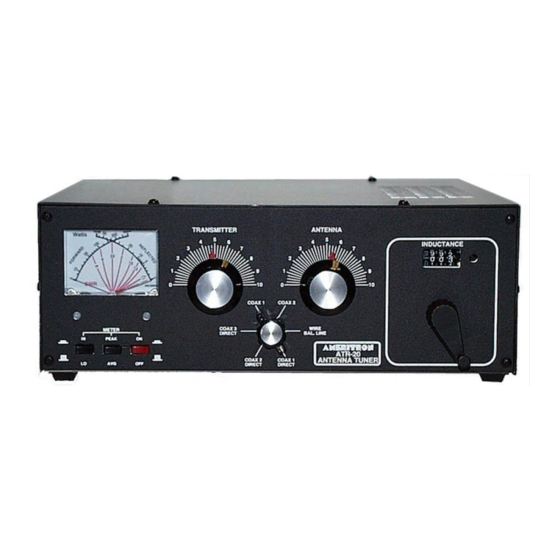AMERITRON ATR-20 Gebrauchsanweisung
Blättern Sie online oder laden Sie pdf Gebrauchsanweisung für Tuner AMERITRON ATR-20 herunter. AMERITRON ATR-20 10 Seiten. Antenna tuner

ATR-20 Instruction Manual
1.0
INTRODUCTION
The ATR-20 is a high power antenna tuner. The ATR-20's roller inductor "T" matching network
continuously tunes all frequencies from 1.8 through 30 MHz. It also features a built-in 3 kilowatt peak or
average detecting directional power meter. The ATR-20 has rear panel connectors for coaxial and wire
feedlines. A heavy duty, high voltage insulated, current-type balun allows use with balanced feedlines.
Properly tuned, the ATR-20 safely operates on all bands with RF power levels of 1.2 kilowatts SSB and
600 watts CW with load impedances from 25-800 ohms. Matching range also extends from one ohm to
2500 ohms (5 ohms to 500 ohms on 160 meters) at slightly reduced power ratings. Peak and average
forward power, reflected power, and SWR are displayed on an illuminated cross-needle meter.
An internal six position antenna-selector switch selects three coaxial line outputs, or a single wire line-
balanced line output. Two coaxial line outputs, ANTENNA 1 and 2, are available in either "tuned"
(with tuner's matching network in line) or "direct" (no matching circuit) configurations.
Coaxial output port ANTENNA 3 is available only as a direct (no matching system) configuration.
WIRE / BALANCED LINE positions are available only as "tuned" configurations.
1.1
Understanding Power Ratings
Unlike amateur radio service amplifiers (commonly rated in RF power output delivered to 50 ohm
resistive loads), tuners have no standard power rating method. Power level descriptions (i.e. "3 kW
Tuner") used for tuners often carry over from the time when amplifiers were rated by peak power input.
For example, the Kilowatt Johnson Matchbox was designed to handle a typical 1000 watt dc input plate
modulated AM transmitter. Such transmitters developed 3000 watts PEP RF output on AM. Matching
tuners were called one kilowatt tuners.
Years later SSB became popular. The Heathkit SB-220 was called a two kilowatt amplifier, even though
rated CW output was approximately 600 watts. Tuners from the same era were called 2 kilowatt tuners,
because they safely handled the 2 kilowatt PEP input SB-220. The 2 kW tuner only had to handle 600
watts of CW and 1200 watts PEP SSB to be compatible with a 2 kW amplifier of the same era.
Around 1980, the FCC changed the amateur radio power rating system from dc power amplifier input
power to RF envelope (output) power. Most tuners stayed with the old system, and no longer follow
amplifier power ratings. Typical "1500 watt tuners" safely handle only 400-600 watts CW, and 600-900
watts PEP SSB.
Note: This tuner is rated by true RF output power, not by the old method of using amplifier peak input
power.
Load conditions and control settings greatly affect tuner power ratings. T-networks typically handle
more power on higher frequency bands into higher load impedances. The worst operating condition (for
T network tuners) is a low-impedance capacitive-reactance load. T-network tuners handle the least
power on 160 meters with low-impedance capacitive-reactive loads.
Follow the guidelines in this manual to avoid exceeding the ratings of this tuner!
1
Ameritron Antenna Tuner
